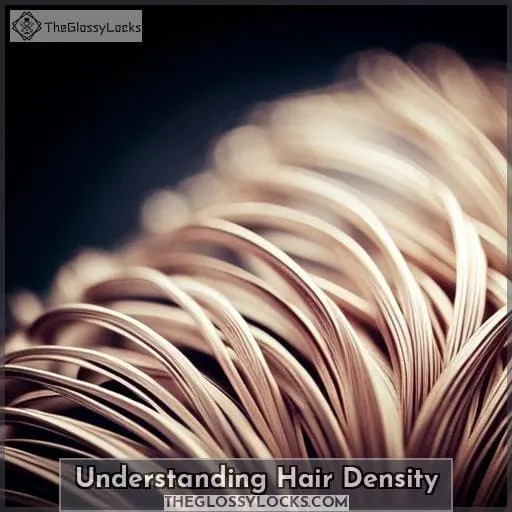This site is supported by our readers. We may earn a commission, at no cost to you, if you purchase through links.
 Do you know your hair’s density? If not, it’s time to figure it out. Hair density is an important factor when determining what type of hair products and styles are best suited for your locks. You’ll need a basic understanding of how to measure the number of hairs per square inch on your scalp in order to determine what kind of haircare regimen and styling techniques will work for you.
Do you know your hair’s density? If not, it’s time to figure it out. Hair density is an important factor when determining what type of hair products and styles are best suited for your locks. You’ll need a basic understanding of how to measure the number of hairs per square inch on your scalp in order to determine what kind of haircare regimen and styling techniques will work for you.
Let’s take a look at everything there is to know about hair density: types, measurement methods, factors that affect it, care tips based on different densities as well as information regarding potential treatments like transplants or analysis preferences related to privacy concerns.
Knowing more about this topic can be empowering so let’s start exploring!
Table Of Contents
Key Takeaways
- Hair density is categorized as low, medium, or high and is affected by factors such as ethnicity, age, and nutrition.
- Density determines product and styling needs, with low-density hair requiring less product and different styling techniques.
- Density can be assessed at home with simple tests like the ponytail test and scalp visibility check.
- Maintaining healthy hair requires understanding your density and practicing proper hair care and diet.
Understanding Hair Density
You can easily visualize the difference in thickness between low, medium, and high-density hair by taking a look at your scalp. Low-density hair may appear thin and fine, while high-density hair will seem thick and full of volume.
Human hair density varies significantly depending on ethnicity, with some populations having denser strands than others. Additionally, age also plays an important role, as nutritional deficiencies tend to decrease density over time.
To measure hair density accurately, trichoscopy or phototrichogram are common clinical methods used by professionals. However, the Ponytail Test or Scalp Test provide reliable alternatives for personal use to identify different types of densities at home.
Styling routines vary according to each type of density but generally require lightweight products that support hydration and volumizing solutions when necessary for low/medium densities. On the other hand, heavier options like frizz-taming serums might be beneficial for those with higher volumes.
Types of Hair Density
There are three distinct varieties of scalp hair, ranging from low to high: low-density hair, medium-density hair, and high-density hair. Low density usually appears thin and fine; it may require styling products for volume.
Medium density is considered normal for most people.
High density looks thick and full with lots of body. Hair thickness and density are different concepts; while thickness refers to the size or diameter of each strand, the number per square inch defines a person’s overall level of scalp coverage or hair volumeness known as hair density.
Nutritional deficiencies can reduce one’s levels over time, so maintaining a balanced diet with essential nutrients will support healthy growth patterns in individuals regardless of their ethnicity or age group.
Hair care should also be tailored based on individual needs – lightweight products help give lift to sparse locks, whereas heavier serums tame unruly frizz that comes with higher densities.
Trichoscopy combined with phototrichogram techniques allow clinicians to measure both parameters accurately, but there is an easy home test involving ponytail circumference which yields similar results too!
So no matter what type you have – make sure you know your personal numbers before adjusting any routines accordingly for best results!
How to Measure Hair Density
Measuring hair density can be done in a variety of ways, such as the Ponytail Test and the Scalp Test. The Ponytail Test helps to determine hair density based on ponytail circumference, whereas the Scalp test assesses it through observation of scalp visibility.
Both tests provide an accurate measure for understanding one’s hair density level, which is essential for choosing appropriate care and styling routines.
The Ponytail Test
Take the Ponytail Test to get an accurate reading of your hair density. To do this, gather all the strands of your hair into a ponytail and measure its circumference with a measuring tape. Divide this value by three to determine how many average-sized hairs make up that bundle.
The Ponytail Test is an easy way to determine volume for any type of hairstyle without having to count individual strands or use complicated instruments such as phototrichograms.
The Scalp Test
Examine the visibility of your scalp to determine hair density. Variations in scalp visibility can indicate differences in hair thickness and health, as well as how much nutrition is available for proper growth.
To conduct a Scalp Test:
- Part your hair down the middle to observe any variations between the left and right side of your head.
- Inspect for bald spots or patches that are thinner than other areas on both sides.
- Check if there are larger amounts of hairs at certain points and lesser amounts elsewhere.
- Note if one area feels thicker than another due to more volume from an increased number of hairs.
A Scalp Test can help you assess whether nutritional deficiencies may be preventing healthy hair growth or identify potential causes behind thinning strands.
Factors Affecting Hair Density
Hair density is an important factor to consider when it comes to the health and appearance of your hair. Nutritional deficiencies or changes in age can affect the number of hairs per square inch on your scalp, so it is important to be aware of how these factors might influence your hair density.
Nutritional Deficiencies
Nutritional deficiencies can drastically reduce the number of hairs on your head, so make sure you’re getting all the essential vitamins and minerals for healthy hair growth. A balanced diet with nutrient-rich foods is key to maintaining strong, thick locks.
An inadequate dietary intake can also lead to dullness and thinning of the hair over time. Additionally, certain micronutrients have been shown to play a critical role in promoting healthy scalp conditions and supporting normal keratin production that keeps strands looking full and voluminous.
To keep your tresses looking their best, be sure to incorporate plenty of fruits, vegetables, and lean proteins into your daily routine for optimal hair health!
Age
Ageing affects your hair density, gradually diminishing it with time. Hair loss increases in older adults due to age-related changes in the body’s metabolism and hormone levels. This can lead to a decrease in hair thickness and density as well as overall thinning of the scalp over time.
To prevent or minimize this decline, individuals should maintain healthy lifestyle habits such as eating a balanced diet rich in essential nutrients and engaging in regular exercise, which support healthy follicle growth.
Additionally, topical treatments like minoxidil may help slow down the progression of baldness by stimulating new growth, while transplants can restore lost volume for those who are severely affected by age-related hair loss.
Care and Styling Tips for Different Hair Densities
When it comes to hair density, there are three distinct types: low-density hair, medium-density hair, and high-density hair. Low density is characterized by thin or fine strands that may require styling products for volume.
Medium density is the most common type of texture and usually requires hydration and regular trims to maintain its health. High-density locks appear thick with lots of body; they typically need heavier products like frizz-reducing serums for optimal results.
Low-Density Hair
If you have low-density hair, it may appear thin and fine, requiring special styling products. To support healthy hair growth, focus on nutrition with essential nutrients. Supplements can also help increase volume and nourish the scalp.
Hair care tips for low-density hair include using lightweight products, volumizing shampoos to boost thickness, serums for reducing frizziness, trims to maintain health, and regular conditioning treatments.
Medium-Density Hair
You may have noticed that your hair has more volume than those with low-density, but less than high-density locks. Medium density styling requires the right products to keep texture and volume intact. Use thickening shampoos and conditioners for added fullness, as well as lightweight mousses or gels for hold.
A shorter haircut can help accentuate medium-density hair’s natural body; however, be careful not to go too short or it’ll look sparse rather than voluminous! Regular haircuts are also important to maintain healthy ends and shape so you don’t lose any of the movement in your strands.
Finally, use a weekly deep conditioning treatment on mid-length to long lengths of hair for softness and shine—the perfect combo when styling medium density tresses!
High-Density Hair
Experience thicker, fuller-looking locks with high-density hair! Achieve enviable volume and bounce with the right styling products.
- Hair serums for extra shine
- FUE transplants to boost thickness
- High-density styles to maximize fullness. Finish off your look with cookies, a must for thick hair lovers!
Promoting Healthy Hair Density
Maintaining a balanced diet and using the right hair care techniques are essential for promoting healthy hair density. Eating foods rich in vitamins, minerals, proteins, fatty acids, and antioxidants can help support natural growth, while avoiding heat styling tools and chemical treatments can limit damage to the strands.
Additionally, using specialized products designed for your specific type of hair density is key to achieving maximum volume or softness.
Maintaining a Balanced Diet
Eating a balanced diet with essential nutrients helps keep hair looking full and healthy. Nutritional benefits from nutrient-rich foods can promote stronger, shinier locks and help maintain hair density over time.
A diet that supplies the body with vitamins, minerals, proteins, and other vital components is key to achieving optimal hair growth. Hair health can be impacted by dietary choices; therefore, it’s important to focus on eating fresh fruits and vegetables as well as lean protein sources for long-lasting results.
Additionally, some supplements could be beneficial depending on individual needs or deficiencies in order to further support collagen production, which aids in keeping the scalp strong while helping increase the volume of your tresses too!
Maintaining a balanced diet will ensure you’re getting all the necessary nutrients for boosting your mane without having any adverse effects later down the line!
Hair Care Techniques
To promote healthy hair density, try incorporating specialized care techniques tailored to your specific hair type. Low-density locks need lightweight products and volumizing solutions to boost volume.
Medium-density follicles benefit from hydration and regular trims for definition and shine. High-density manes may require heavier styling products with frizz serums for texture enhancement.
Hair Density and Hair Transplants
Hair density is an important factor when considering a hair transplant procedure. FUT (Follicular Unit Transplantation) and FUE (Follicular Unit Extraction) are two commonly used techniques for this type of surgical intervention, which involves transferring healthy follicles from one area to another in order to improve the overall look of the scalp.
FUT (Follicular Unit Transplantation)
FUT is a type of hair transplantation technique, also known as follicular unit transplantation. It offers an effective solution for restoring lost hair density. With FUT, individual grafts are harvested from the donor area in strips and transplanted to the target areas with precision.
FUE involves extracting single units without harvesting strips of skin for greater accuracy and minimal scarring post-operation.
Hair transplant costs vary depending on factors like the amount of hair needed, the complexity level, or the method used.
Post-transplant care plays an essential role in achieving optimal results.
Hairline design should be tailored according to each person’s facial structure.
Donor area healing requires proper aftercare instructions given by your doctor at every stage during the recovery period.
FUE (Follicular Unit Extraction)
Discover the difference between FUT and FUE, two leading hair transplant techniques that are revolutionizing the way people tackle thinning hair. FUE is a minimally invasive procedure in which individual follicular units (grafts) containing one to four hairs each are harvested from donor areas of higher density before being transplanted into recipient sites where they take root and begin growing.
It offers improved results with minimal scarring due to its precision technique, as well as shorter recovery times compared to traditional strip harvesting methods like FUT. Furthermore, it can be more cost-effective for those with smaller balding areas since only grafts needed for coverage need to be extracted from donor sites while still achieving natural-looking results based on the degree of existing hair density and texture at both locations.
Privacy Preferences for Hair Density Analysis
You never know who’s got their eye on your hair density, so make sure you’re comfortable with the level of privacy around it! Everyone has a right to control how their data is collected and used, especially when it comes to something as personal as hair density analysis.
Make sure you understand what data protection measures are in place for any service or company that collects information about your scalp and hair health. Ensure they have clear consent management policies that allow people to opt-in or out of certain services, such as targeted marketing campaigns based on data gathered from scans and tests.
Consider the ethical considerations involved in collecting sensitive personal information like this. Be aware if companies adhere strictly to confidentiality measures, such as using anonymized datasets instead of raw user profiles for research purposes.
You might also want to check if they provide users with a Privacy Preference Center where visitors can view all active cookies on their device before creating an account, allowing them greater control over which ones remain enabled after signup.
Taking these steps will help ensure your safety and give you more confidence when providing detailed information about yourself online!
Conclusion
It’s essential to understand the concept of hair density to ensure healthy hair growth and a beautiful appearance.
Hair density varies by ethnicity, age, and nutrition. It can be measured using the Ponytail Test and the Scalp Test.
Low-density hair requires lightweight styling products to add volume. Medium-density hair should focus on hydration and trims.
To maintain healthy hair density, it’s important to maintain a balanced diet and use the appropriate hair care techniques.
Hair transplants, such as FUT and FUE, can also be used to restore hair density.
Ultimately, understanding hair density is key to achieving the desired hair look and feel.











